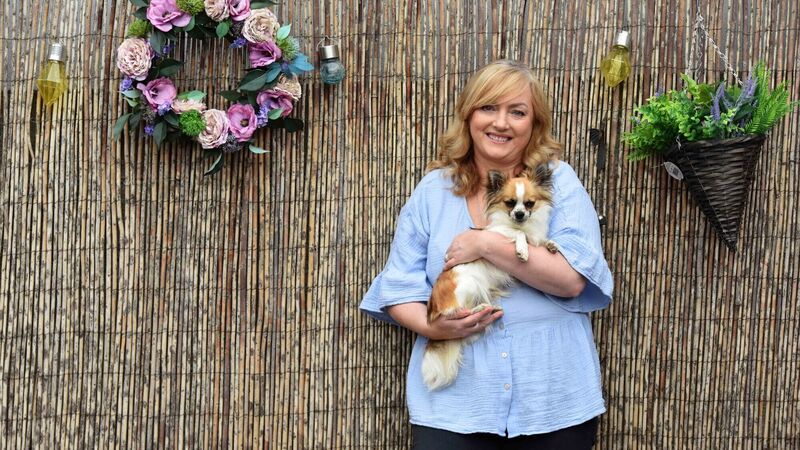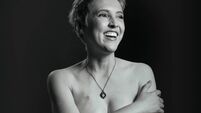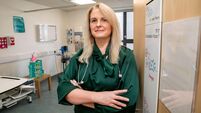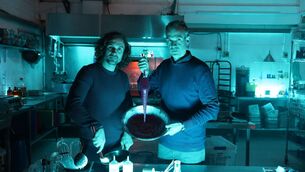Mum of three who had mole on leg says 'my friends and family actually saved my life'

Rachel Wynne who was diagnosed with stage 2 melanoma in 2018. with he dog Gizmo. Photograph Moya Nolan
For about a year, whenever she was getting dressed, Rachel Wynne noticed the large mole on her left leg. Halfway between her knee and groin, it looked like a patch of dry skin.
“It wasn’t sore or itchy and it didn’t bleed. I’d put moisturiser on it, thinking that would take it away,” says the Dublin mum-of-three.
Rachel, who works as a receptionist in a beauty salon, always intended to mention it to the GP on her next visit but never got around to it. “In that year I was probably with the GP four or five times, never for myself – it would have been for the kids. Each time I’d leave and think ‘oh, I never mentioned the mole’.”
In 2018, a week before attending her sister Rebekah’s wedding in Portugal, she was trying on swimsuits in her bedroom when her husband, Garry, remarked: “That thing on your leg looks really funny.”
He wasn’t the only one with concerns. “There was a big gang of family in Portugal for the wedding and every day at the pool a different person would say ‘what’s that on your leg? You need to get that checked’. I was so sick of everyone saying it to me that I covered it with a plaster.”
By now the mole had changed in appearance. “It went from being dry skin to being raised. It looked like a raisin, a bit wrinkly and bubbly. My husband said it looked multi-coloured when the sun shone on it. From my perspective, I couldn’t see that – I could just see it was black.”
Once home, Rachel made an appointment with a dermatology clinic, where the doctor said it looked like ‘textbook melanoma’. He referred her to the Blackrock Clinic for a biopsy.
“Even then, Garry and I didn’t think in terms of serious illness. We thought ‘they’ll just remove it – it’s not a big deal’.”
After a 10-day wait, Rachel, then aged 46, was told to bring someone with her the day she was getting the biopsy results. “I knew then it was cancer. And the doctor said, unfortunately, it was bad news, it was melanoma and it was deeper than they’d expected.”
Referred to Beaumont Hospital, Rachel had a wide leg excision and a sentinel lymph node biopsy in October 2018. It was the height of the CervicalCheck controversy and she waited six weeks to know if the cancer had spread. “After the first clear result, they wanted a second opinion just to be sure,” she says.
She got the fantastic all-clear news on the day her sister, Leah, was celebrating her 40th birthday. “We had a great night,” recalls Rachel, now aged 50.
For the next three years, Rachel had check-ups every three months and had three moles removed – none cancerous. “Now I get checked every six months. Then it will be yearly for five years, but my dermatologist plans to bring me back every year or two because of my history and the number of moles I have.”
Rachel has totally changed her behaviour around the sun. “I always wore sunscreen on holidays but probably not at home in Ireland, unless it was really sunny and I was at the beach. Now, I wear sunscreen all the time. I stay in the shade. I wear long sleeves, long trousers, and a hat. On holiday I put on a thicker layer of sunscreen.”
With her youngest child, Danny, aged 10 – she also has Chloe, 23, and son Jamie, 20 – it can be hard to avoid being in the sun. “If we’re on holiday Danny wants me to be in the pool with him. If I get in, it’s for 10 minutes. Then I’m out, more sun cream on and I’m covered up again.”
Highly conscious of the need to protect skin from UV rays, Rachel takes every opportunity to spread the message. “I probably annoy people. If I see someone with sunburn or tan lines, I tell them they need to be really careful. A lot of people don’t want to hear it.”
Rachel feels hugely grateful for how lucky she has been. “I’ve met people through Facebook, who had the same cancer as me but they didn’t have the same outcome.
“I’m so thankful to my friends and family. They actually saved my life.”

Donna Spillane, cancer nurse at Irish Cancer Society, outlines what we need to know about skin cancer, which comprises melanoma (more aggressive), and non-melanoma skin cancer (NMSC) and is the most common form of cancer in Ireland.
For melanoma, think alphabetically – ABCDE (asymmetry, border, colour, diameter, evolving) are the characteristics of skin damage doctors look for when diagnosing melanomas.
Asymmetry: Melanoma is often asymmetrical – shape isn’t uniform. Non-cancerous moles are typically uniform and symmetrical in shape.
Border: Melanoma often has borders that aren’t well defined/are irregular in shape. Non-cancerous moles usually have smooth, well-defined borders.
Colour: Melanoma lesions are often more than one colour/shade. Benign moles are typically one colour.
Diameter: Melanoma growths are normally larger than 6mm in diameter – diameter of a standard pencil.
Evolution – Melanoma will often change characteristics (size/shape/colour). Unlike most benign moles, melanoma tends to change over time.
If you’ve a suspicious mole/lesion, see your doctor. Most aren’t cancerous but best get it checked. Caught early, most skin cancer, including melanoma, can be cured.
-Ultraviolet (UV) light from sun exposure including exposure to tanning lamps/sun-beds. UV radiation causes DNA damage in our skin which can lead to skin cancer. UV is usually strongest between 11am and 3pm from April to September in Ireland, even when it’s cloudy.
-Regular sun holidays, working outdoors, outdoor sports or severe sunburn/blistering as a child/teen may increase risk of developing skin cancer later in life.
-Fair skin that freckles or burns easily, with fair or red hair and blue, green or grey eyes.
-Having large number of moles or moles which look unusual.
-Age: Risk increases with age, but skin cancers are becoming increasingly common in younger people.
-Family history – having family member with skin cancer.
Follow the SunSmart Five S’s of Slip, Slop, Slap, Seek and Slide, to ensure you’re prepared/protected in the sun – see: exa.mn/Skin-Cancer-Prevention

Celebrating 25 years of health and wellbeing







